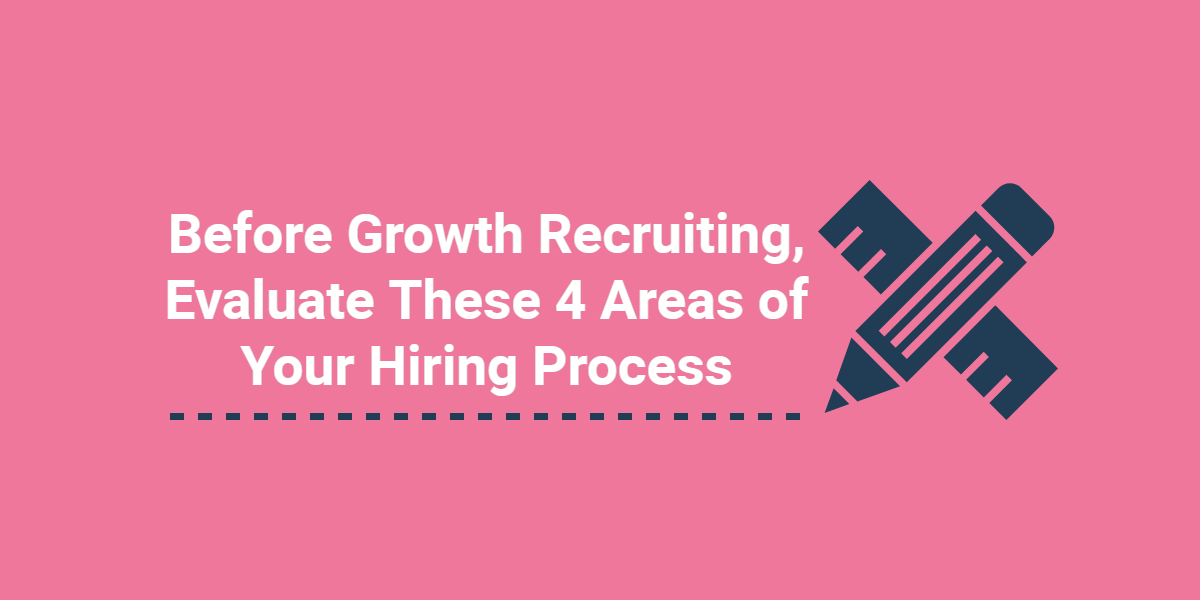You’re preparing for rapid company growth. It’s an exciting time as you look at the end goal. However, growth recruiting doesn’t just happen overnight. When you’re preparing to expand, you need a hiring process that is fast and efficient.
From how you develop and maintain your employer brand to how you hire for cultural fit, every single aspect of your hiring process needs to be evaluated before you start growth recruiting.
Why?
Your company can’t grow if your hiring process is slow and inefficient. If you aren’t aware of your hiring problems now, they will only magnify when you’re trying to recruit a lot of talent at one time.
To successfully prepare for growth recruiting, first, look at the areas of your strategy that need to be tweaked:
Identifying Hiring Needs
You should already have a process in place for identifying what roles you will need to hire for. If you don’t, you won’t know what jobs you need to create to drive company growth.
Tips: Establish a plan that helps you identify upcoming talent needs. Group types of expertise and tasks you expect into various positions.
With this job analysis, ensure you know what exactly each prospective role entails. Ask employees to help write updated job descriptions. This ensures you’re posting the most accurate description that captures all the current responsibilities.
If you’re creating new positions, ask for your employees’ feedback on the job description. Their perspective is valuable because they know how that new role would impact the entire team.
Once you have your job needs and roles clearly defined, create candidate profiles detailing the best person for each position. Consider character/personality traits and skills that will align with the current team or fill gaps. You’ll use this profiles when sourcing for top talent to ensure you’re hiring for long-term success.
Sourcing for Talent
Candidate sourcing is where you can save a lot of time in your hiring process. If your source caused bad hires, it will likely lead you down that path in the future.
Tips: Build a talent pipeline now. When it’s time to hire a lot of people, you will have established relationships with highly qualified candidates. At that point, the candidates already showed interest in working with you.
As you start building your talent pipeline, you will see if your employer brand is effective at attracting top talent. Consider adopting a grassroots social media recruiting process, where you connect with talent directly.
Look through communities online to find talent that has relevant expertise. Then, reach out personally to let them know they would be a great fit for your company.
Assessing Your Candidates
One of the most time-consuming parts of the hiring process is evaluating candidates. You Especially when looking to take the time to read through every qualified candidate when you’re rapidly growing and thus needing to hire faster.
Tips: To ensure you can effectively and efficiently review each candidate, make sure you have developed candidate personas for each of the prospective roles. This way, you can efficiently determine fit.
Start by looking at performance data from your current employees. Look for trends in background and experience to see if it impacts performance. If your sales managers are more productive with five years of experience, set that as a requirement.
Collaborate with your team to create these personas. They often have a strong idea of what it takes to succeed.
Then, use these personas to guide your interview questions. Sending these questions to candidates through one-way video interviews allows you to efficiently connect with the candidate and efficiently review their responses while gaining greater insight than a resume or written questionnaire alone.
Creating a Candidate Experience
Losing top talent during the hiring process is frustrating, but it’s usually preventable. If you’re attracting A players with strong branding and smart social media recruiting, you need to keep them engaged throughout the process.
A bad candidate experience will push people away and might even impact your reputation. In turn, this will make it harder to attract other awesome applicants.
Tips: Run through the entire hiring process with your employees to ask for their feedback on what the candidate experience looks like now. The mock experience allows your hiring team and your employees to determine where the candidate might feel forgotten or frustrated.
Another great way to assess the candidate experience is surveying recent hires. Ask them what they thought about how you contacted them, how you conducted interviews, and how you offered them the position.
One common issue is communication. In fact, CareerArc’s 2016 survey found that six of 10 candidates said better communication throughout the process would have the most positive impact.
To keep candidates in the loop, provide a ‘candidate guide’ to whoever applies. This content should include a description of your hiring process, a detailed timeframe, and what actions they need to take on their end.
Once you smooth out the wrinkles in your current hiring process, you’re ready to build a growth recruiting framework.
—
What aspects of your hiring process do you need to improve for growth recruiting? Share in the comments!











